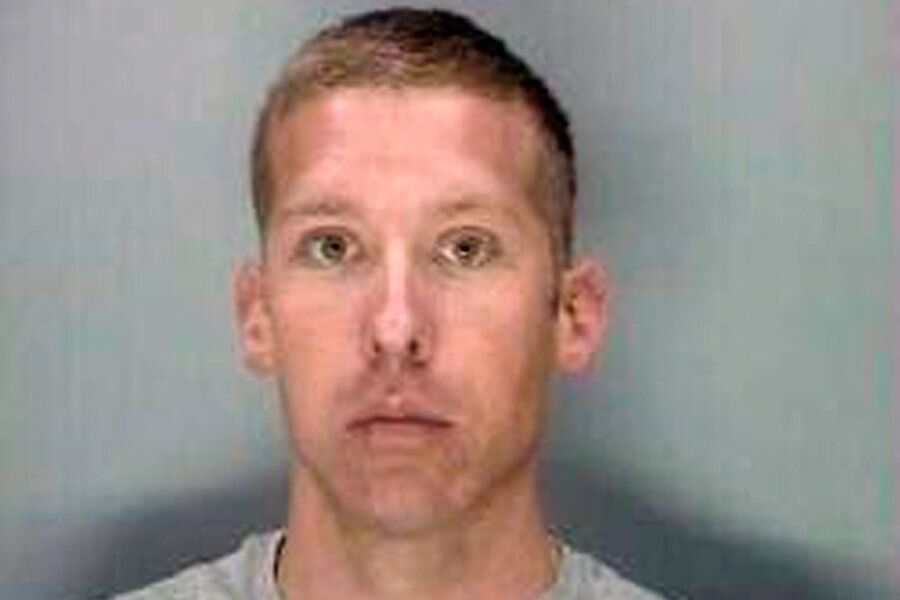S.C. cop in trouble for shooting unarmed man: 'Sir, why was I shot?'
Loading...
| Atlanta
Amid a number of US inquiries into worrisome police behavior, some critics are asking a difficult question: Have American police officers’ trigger fingers gotten too itchy?
South Carolina authorities on Wednesday released a dashcam video showing former Highway Patrol officer Sean Groubert asking motorist Levar Jones, who is black, to get his license and then shooting him in the hip as he reaches into his car for the license.
"Sir, why was I shot?” Mr. Jones, who is recovering from the shooting, can be heard saying.
The Sept. 4 incident led to the Highway Patrol firing Mr. Groubert, who was charged Wednesday with armed aggravated assault, which could lead to a 20-year prison sentence, if he’s convicted.
In other police shooting news, inquiries into the death of Michael Brown continue in St. Louis; the Department of Justice is reviewing a Ohio case where officers killed 22-year-old John Crawford, who is black, as he talked on a cell phone while holding, but not aiming, a BB gun at Walmart; and police in Savannah, Ga., last week shot and killed a handcuffed black man after he allegedly pulled out a hidden gun.
Over the past few years, certain cities have been hotspots for higher than average police shootings. Albuquerque saw 26 police shootings in four years before federal officials stepped in, calling some of the deadly shootings unjustified and blaming a culture of “aggression.” A Department of Justice report suggested that the city hire better officers, and then train them better.
Criminologists add that the kinds of police shootings historically seen in big cities also seem to be happening more in small town America.
To be sure, policing experts say it’s easy to Monday-morning-quarterback the actions of officers who have to make split-second decisions in the heat of the moment. But while Groubert, the South Carolina officer, was eventually arrested, critics say the rarity of such official sanctions often raise more questions about the ability of police and prosecutors to fairly investigate officers who seem to be too quick to shoot.
“I am troubled by the way that our public lack of trust [in law enforcement] in turn facilitates these acts [like Ferguson], where police take down those some may think of as thugs,” says Jeffrey McCune, an expert on police violence at Washington University in St. Louis. “There’s a tension where, on one hand, police officers are super-people and, on another level, some of them are also criminals, partly because they can manipulate the law, because the law is on their side.”
American police shoot a lot of people, about 1,000 per year, or three per day, according to a reliable tally from news reports kept by the Facebook page “Killed by Cops.” The US Department of Justice, using incomplete and self-reported data from police departments, puts the number at about 400 a year, the vast majority of which are deemed justifiable. The numbers of police shootings have been rising in the last 20 years, from 1.92 justified police homicides per 10,000 violent crimes in 1991 to 3.35 such incidents per 10,000 crimes in 2011.
In that light, police trainers say American police officers are taught to fight, not run, when faced with what they see as dangerous situations.
“The reality is that every day in this country people unlawfully place others in great bodily harm,” forcing police into using deadly force, John Bowman, a professor at the Police Training Institute at the University of Illinois, told ABC News last year.
Race complicates the picture. Many of the past and recent officer shooting cases that have caused community outrage have been the shooting of unarmed and young black males by white officers. The disparity is real, according to a 2005 Florida State University study that found that white officers were more likely to shoot unarmed black civilians than armed white ones in a video simulation.
Referring to a recent White House intruder, Northwestern University sociologist Aldon Morris notes that “you have a man that can run into the White House and not be shot to death and you have an unarmed teenager being shot on the spot – [that disparity] speaks great volumes about the nature of race in America.”
But other researchers have found a different racial dynamic in police shootings. Washington State University researchers found that participants in a study of deadly force were more likely to feel threatened by video scenarios involving black people, but took longer to pull the trigger against the black suspects than either Hispanic or white ones.
Peter Kraska, a police studies professor at Eastern Kentucky University, told ABC News last year he believes the number of shootings in smaller towns may be rising because officers there are dealing with more big-city problems, like an increased flow of illicit drugs into rural America.
But he also adds that small town police officers sometimes do not get the kind of tactical training that could prevent some shootings, even as their departments have become increasingly militarized through controversial Pentagon programs that recycle war equipment for use on Main Street.
To be sure, the shooting of the motorist in South Carolina also underscores that police organizations can and do act against officers in some situations. After firing Groubert, state public safety director Leroy Smith announced that “the force administered in this case was unwarranted, inconsistent with how our troopers are trained, and clearly in violation of department policies.”
Groubert pleaded not guilty and was released on a $75,000 bond.








